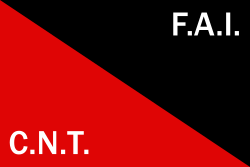
Back النقابية الثورية في كتالونيا خلال الحرب الأهلية الإسبانية Arabic Рэвалюцыйная Каталёнія BE-X-OLD Anarcosindicalisme a Catalunya durant la Guerra Civil espanyola Catalan Anarkistisk Catalonien Danish Anarcosindicalismo en Cataluña durante la guerra civil española Spanish کاتالونیای انقلابی Persian انقلابی کاتالونیا PNB Революционная Каталония Russian Революційна Каталонія Ukrainian انقلابی کاتالونیا Urdu
Revolutionary Catalonia Catalunya revolucionària (Catalan) | |||||||||||
|---|---|---|---|---|---|---|---|---|---|---|---|
| 1936–1937 | |||||||||||
 Territorial division of Catalonia according to the decree of the Generalitat of October 1936 | |||||||||||
| Status | De facto: Quasi-state with syndicalist and stateless features De jure: Autonomous region within a constitutional republic | ||||||||||
| Capital | Barcelona | ||||||||||
| Common languages | Catalan, Spanish | ||||||||||
| Government | De facto: Anarcho-syndicalism De jure: Generalitat of Catalonia | ||||||||||
| President of the Generalitat | |||||||||||
• 1936–1939 | Lluís Companys | ||||||||||
| Legislature | Central Committee of Antifascist Militias of Catalonia (1936) Parliament of Catalonia (1936–1939) | ||||||||||
| Historical era | Spanish Civil War | ||||||||||
| 21 July 1936 | |||||||||||
• CCMA disbanded | 1 October 1936 | ||||||||||
• May Days | 3–8 May 1937 | ||||||||||
| 10 February 1939 | |||||||||||
| |||||||||||
| Today part of | Spain ∟Catalonia | ||||||||||
Revolutionary Catalonia[1] (21 July 1936 – 8 May 1937) was the period in which the autonomous region of Catalonia in northeast Spain was controlled or largely influenced by various anarchist, syndicalist, communist, and socialist trade unions, parties, and militias of the Spanish Civil War era. Although the constitutional Catalan institution of self-government, the Generalitat of Catalonia (led by the Republican Left of Catalonia, ERC), remained in power and even took control of most of the competences of the Spanish central government in its territory, the trade unions were de facto in command of most of the economy and military forces, which includes the Confederación Nacional del Trabajo (CNT, National Confederation of Labor) which was the dominant labor union at the time and the closely associated Federación Anarquista Ibérica (FAI, Iberian Anarchist Federation). The Unión General de Trabajadores (UGT, General Worker's Union), the POUM (Workers' Party of Marxist Unification) and the Unified Socialist Party of Catalonia (PSUC, which included the former Communist Party of Catalonia) were also prominent.
Socialist rule of the region began with the Spanish Revolution of 1936, resulting in workers' control of businesses and factories, collective farming in most of the countryside, and attacks against Spanish nationalists and the Catholic clergy. The growing influence of the Communist Party of Spain's (PCE) in the Popular Front government and their desire to nationalize revolutionary committees and militias brought it into conflict with the CNT and POUM, resulting in the May Days and the eventual replacement of the CNT by the PSUC as a major political force in Catalonia until their defeat to the Nationalist forces in 1939.
- ^ Alexander 1999, p. 754; Graham 2002, p. 221; Paz 2006, p. 512.


